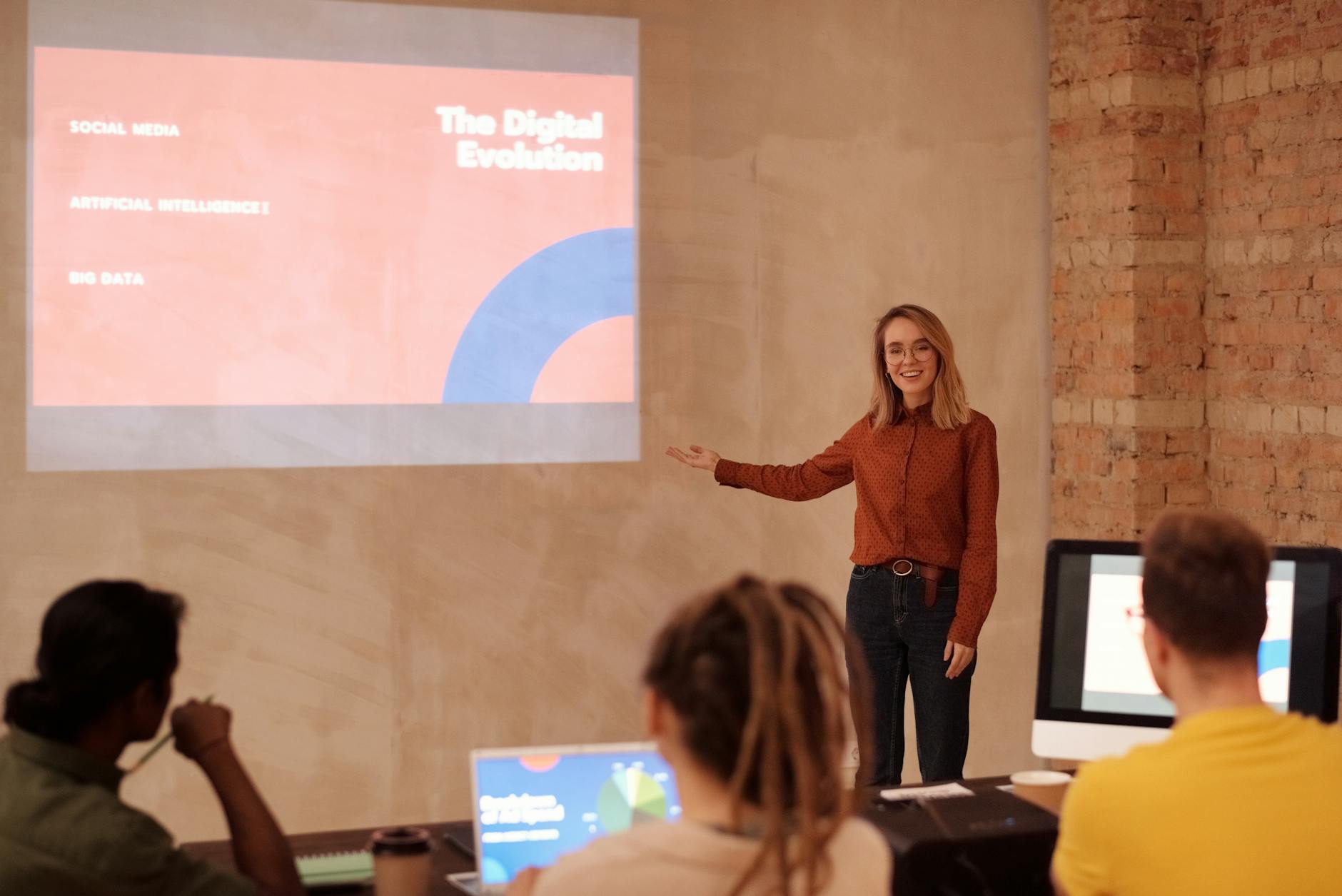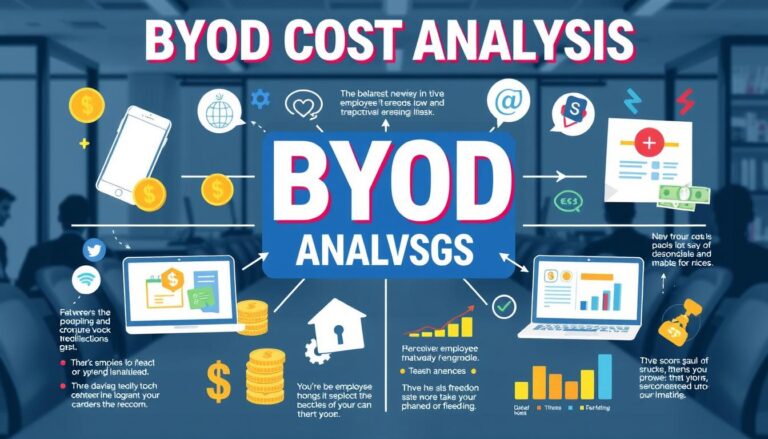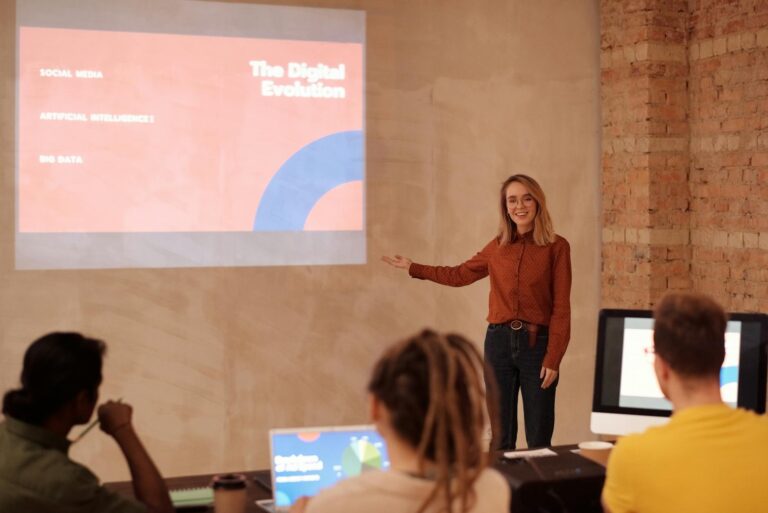2025 Tech Trends Web AI Cloud Mobile Driving Business Success
The 2025 Tech Revolution: Navigating Web Development, AI, Cloud, and Mobile Innovation for Business Growth and Digital Transformation
Estimated reading time: 19 minutes
Key Takeaways:
- 2025 tech trends focus on integrating web/mobile development, AI automation, cloud, and DevOps for business growth.
- Modern web development emphasizes speed and personalization through frameworks like Next.js/React, headless CMS, and AI-powered web apps.
- Mobile app development prioritizes cross-platform efficiency (Flutter vs. React Native) and deep AI integration for smarter experiences.
- Cloud computing and DevOps (serverless, microservices, CI/CD) are crucial for digital agility, scalability, and cost optimization.
- AI automation is revolutionizing business operations and customer service but requires careful consideration of ethical implications and regulatory oversight.
Table of Contents
- The 2025 Tech Revolution: Navigating Web Development, AI, Cloud, and Mobile Innovation for Business Growth and Digital Transformation
- Introduction: The Accelerating Pace of Digital Transformation in 2025
- Web Development Trends 2025: Building the Next-Gen Digital Experience
- Mobile App Development 2025: Innovation on the Go
- Cloud Computing and DevOps in 2025: The Backbone of Digital Agility
- AI Automation for Businesses: Revolutionizing Operations and Customer Experience
- Digital Transformation Strategies and Tech Innovation for Businesses
- Conclusion: Embracing the Future of Tech with AITechScope
- Frequently Asked Questions (FAQs)
- Q1: What are the most significant web development trends to watch in 2025?
- Q2: How does AI automation specifically benefit small businesses in 2025?
- Q3: What is the current status of the Flutter vs React Native debate for mobile app development in 2025?
- Q4: What are the main challenges and solutions for cloud migration in 2025?
- Q5: How can a small business achieve digital transformation on a budget?
- Q6: What ethical considerations are paramount for AI in 2025?
- Q7: How important is UI/UX design in the current tech landscape?
The 2025 Tech Revolution: Navigating Web Development, AI, Cloud, and Mobile Innovation for Business Growth and Digital Transformation
The digital landscape is not just evolving; it’s experiencing a seismic shift. As we navigate through 2025, the fusion of advanced technologies is reshaping every facet of business operations, customer interactions, and product development. From the lightning-fast experiences delivered by modern web frameworks to the intelligent automation driven by AI, the future is now. This comprehensive guide serves as your essential playbook, demystifying the 2025 tech trends that are not merely buzzwords but powerful catalysts for digital transformation strategies and sustained growth.
In an era defined by speed, intelligence, and user-centricity, understanding these trends is paramount. Whether you’re a startup aiming for rapid market entry, an established enterprise seeking to optimize operations, or a developer striving to build the next generation of digital products, the insights within these pages will empower you to make informed decisions and stay ahead of the curve. Join us as we explore the future, revealing how today’s tech innovation for small businesses and large corporations alike can unlock unprecedented potential.
Introduction: The Accelerating Pace of Digital Transformation in 2025
The year 2025 marks a pivotal moment in the ongoing software development 2025 journey. We’ve moved beyond the initial hype cycles, settling into a pragmatic integration of technologies that deliver tangible business value. The emphasis is no longer just on adopting new tech, but on strategically leveraging it to create competitive advantages, enhance customer experiences, and foster operational agility.
This accelerated pace is driven by several factors: the pervasive availability of robust cloud infrastructure, the maturation of AI capabilities, the demand for seamless cross-platform experiences, and the ever-present need for businesses to do more with less. For many organizations, particularly small businesses, the challenge lies in identifying which technologies offer the highest ROI and how to implement them without overwhelming existing resources or budgets. This guide aims to bridge that gap, translating complex tech stack for modern businesses concepts into actionable strategies.
Web Development Trends 2025: Building the Next-Gen Digital Experience
Web development in 2025 is synonymous with speed, intelligence, and unparalleled user experience. The days of static, slow-loading websites are long gone, replaced by dynamic, interactive, and highly performant applications that serve as the primary interface for businesses. The focus here is on delivering content instantly, personalizing interactions, and ensuring robust scalability.
H3: Beyond Static: Dynamic and Performant Web Applications
The demand for instant gratification has pushed web development trends towards frameworks and architectures designed for blazing-fast performance and seamless user journeys.
H4: Next.js and React Performance: The Quest for Speed and Scalability
Next.js and React performance continue to dominate the modern web development landscape. React, with its component-based architecture, provides the foundation for building complex user interfaces, while Next.js elevates this by offering powerful features like server-side rendering (SSR), static site generation (SSG), and incremental static regeneration (ISR).
For Next.js small business site owners, this translates into rapid loading times, improved SEO, and a highly responsive user experience – all critical for capturing and retaining customer attention. A Next.js beginner guide often highlights its developer-friendly environment and built-in optimizations, making it an ideal choice for quickly launching high-performance marketing sites or e-commerce platforms. Developers are constantly seeking 5 Simple React Performance Fixes That Reduce Page Load by Seconds, from memoization and code splitting to optimizing image delivery, showcasing the ongoing commitment to speed.
H4: Micro Frontends: Modular Architectures for Complex Web Apps
As web applications grow in complexity, managing monolithic frontends becomes a significant challenge. Micro Frontends: When They Help and When They Hurt (Practical Examples) demonstrates how this architectural pattern breaks down a large frontend into smaller, independently deployable units. Each micro frontend can be developed, tested, and deployed by a separate, autonomous team, leading to increased agility, faster development cycles, and improved scalability for large enterprise applications. This approach is particularly beneficial for organizations with multiple product lines or geographically dispersed teams.
H4: Serverless Architecture for Web Development: Efficiency and Cost Savings
Serverless architecture is revolutionizing how backend services are built and deployed for web applications. By abstracting away server management, developers can focus purely on writing code, and applications automatically scale up or down based on demand. This translates into significant cost savings, as you only pay for the compute resources consumed. For fast marketing sites or data-intensive applications, serverless functions can provide a highly efficient and scalable backend.
H3: The Rise of Headless: Content Management for a Multi-Platform World
Content is king, and in 2025, that content needs to be accessible across an ever-growing array of devices and platforms, from traditional websites to mobile apps, smart displays, and voice assistants.
H4: Headless CMS WordPress: Unlocking Flexibility and Performance
While traditional WordPress can be prone to “bloat,” Headless CMS WordPress offers a powerful solution. By decoupling the content management backend (WordPress) from the frontend presentation layer, developers can use modern frameworks like Next.js or React to consume content via APIs. This approach provides the familiar ease of use for content creators within WordPress while delivering superior performance, security, and flexibility on the frontend. Utilizing WordPress Without the Bloat: Lightweight Plugins That Actually Help SEO becomes even more effective in a headless setup, ensuring optimal content delivery without unnecessary overhead.
H3: AI-Powered Web Apps: Intelligent Interactions and Personalization
AI-powered web apps are moving beyond simple automation to deliver truly intelligent and personalized experiences. Artificial intelligence is no longer an add-on but an integral part of the user journey.
Integrating AI into web experiences ranges from advanced search capabilities and personalized content recommendations to dynamic pricing and intelligent analytics that adapt the UI based on user behavior. This not only enhances engagement but also drives conversions by presenting users with exactly what they need, often before they even know they need it.
H3: Modern UI/UX Design: Intuitive, Responsive, and Accessible Experiences
The aesthetic and interactive aspects of an application are crucial. Modern UI/UX design in 2025 emphasizes responsiveness, inclusivity, and intuitive flows that delight users and reduce friction.
H4: Responsive UI Design: Beyond Mobile-First
While mobile-first remains a fundamental principle, responsive UI design in 2025 extends to designing for an increasingly diverse array of screen sizes and input methods. This includes foldable devices, large desktop monitors, interactive kiosks, and even augmented reality interfaces. The goal is a truly fluid experience that adapts seamlessly to any context, ensuring consistent usability and brand presence.
H4: Designing Accessible Buttons: A Non-Designer’s Guide (Figma Tips)
Accessibility is no longer an afterthought; it’s a core requirement for good design. Designing Accessible Buttons: A Non-Designer’s Guide (Figma Tips) highlights the importance of inclusive design practices. This means ensuring web applications are usable by people with disabilities, covering aspects like keyboard navigation, sufficient color contrast, clear focus indicators, and semantic HTML. Accessibility not only expands your audience but also improves SEO and overall user experience for everyone.
Mobile App Development 2025: Innovation on the Go
Mobile devices remain the primary access point for digital services for billions worldwide. Mobile app development 2025 is characterized by the continued evolution of cross-platform solutions, deeper AI integration, and user interfaces that prioritize immersive and highly personalized experiences.
H3: Cross-Platform Supremacy: Flutter vs React Native in 2025
The debate between native and cross-platform development has largely settled, with cross-platform frameworks emerging as dominant players due to their efficiency and speed to market.
H4: Which Mobile Framework for Startups? Pros and Cons
The perennial question of Flutter vs React Native in 2025 continues to be a hot topic, especially for startups. Both frameworks allow developers to write a single codebase that deploys to iOS and Android, drastically reducing development time and cost.
- Flutter, backed by Google, offers exceptional UI rendering capabilities and performance akin to native apps, thanks to its Skia graphics engine. It’s ideal for visually rich applications and provides a consistent UI across platforms. For startups looking to Build a Simple Cross-Platform App with Flutter: From Idea to Play Store, its hot reload feature and extensive widget library are invaluable.
- React Native, leveraging JavaScript and React’s popularity, has a massive community and a vast ecosystem of libraries. It’s often favored by teams already proficient in web development with React.
The choice of which mobile framework for startups largely depends on existing team skills, specific performance requirements, and the complexity of the UI. Both are excellent choices for quickly delivering robust mobile experiences.
H3: AI and ML in Mobile Apps: Smarter and More Predictive Experiences
AI is rapidly moving from the cloud to the edge, enabling powerful machine learning capabilities directly on mobile devices. This trend translates into more responsive, personalized, and offline-capable mobile applications.
Expect to see deeper integration of AI for personalized content feeds, proactive recommendations, intelligent search, on-device fraud detection, and even predictive maintenance for IoT-connected devices. Augmented Reality (AR) experiences, powered by on-device AI, are becoming more sophisticated, offering immersive shopping, gaming, and educational applications.
H3: Mobile App UI Trends: Immersive and Intuitive Interactions
Mobile app UI trends are pushing towards more immersive, gesture-driven, and multimodal interaction patterns.
- Voice UIs are becoming more prevalent, allowing users to interact with apps using natural language.
- Haptic feedback is being creatively used to provide tactile responses, enhancing the sense of immersion.
- Micro-interactions are polished to provide delightful and informative feedback.
- Dark modes and customizable themes are standard, offering user preference and reducing eye strain.
The goal is to create interfaces that feel natural, anticipatory, and deeply integrated into the user’s daily workflow.
H3: Enterprise Mobile Adoption: Empowering the Modern Workforce
Beyond consumer apps, enterprise digital adoption strategies heavily rely on mobile applications to empower the modern workforce. Custom enterprise apps are streamlining workflows, providing on-the-go access to critical business data, and enhancing field service operations. These applications often incorporate advanced security features, offline capabilities, and integrations with existing backend systems, ensuring productivity and compliance.
Cloud Computing and DevOps in 2025: The Backbone of Digital Agility
Cloud computing has matured into an indispensable foundation for modern businesses, providing scalable, flexible, and cost-effective infrastructure. Coupled with DevOps practices, it creates an environment of continuous innovation and rapid delivery.
H3: Cloud Migration Strategies: Seamless Transitions to the Cloud
The shift to the cloud is no longer optional. For many enterprises, the focus is on optimizing existing cloud deployments and strategically migrating legacy systems.
H4: Moving Legacy Apps to the Cloud Without Breaking It
One of the biggest challenges for established businesses is How to Move Your Legacy App to the Cloud Without Breaking It. This requires careful planning, often involving a phased approach (rehost, replatform, refactor, rearchitect) to minimize disruption. Strategies include containerization, lift-and-shift, or selectively refactoring components into microservices. The goal is to leverage cloud benefits like scalability and cost-efficiency without jeopardizing critical business operations.
H4: Hybrid and Multi-Cloud Architectures
As businesses mature in their cloud journey, hybrid and multi-cloud architectures are becoming standard. Hybrid cloud allows organizations to maintain some infrastructure on-premises while leveraging public cloud services, offering greater control and compliance. Multi-cloud strategies involve using multiple public cloud providers, reducing vendor lock-in and maximizing flexibility for specific workloads or regions.
H3: DevOps Best Practices and CI/CD Automation: Accelerating Delivery
DevOps best practices are central to modern software development, fostering collaboration between development and operations teams to accelerate the delivery of high-quality software. CI/CD automation (Continuous Integration/Continuous Delivery) pipelines are the engine that drives this agility.
H4: CI/CD for Small Teams: Automated Deployments Without the Headache
Even for smaller teams, CI/CD for Small Teams: Automated Deployments Without the Headache is a game-changer. Automation of testing, building, and deployment processes significantly reduces manual errors, frees up developer time, and ensures consistent deployments. Tools like GitHub Actions or GitLab CI/CD provide accessible platforms for implementing robust pipelines. A GitHub Actions deploy tutorial can quickly get a small team up and running, ensuring code changes are automatically tested and deployed to production, enabling a CI CD small team to achieve enterprise-level agility.
H3: Serverless Architecture: Cost-Efficient and Scalable Backends
Serverless computing continues its ascendancy, offering unparalleled scalability and cost efficiency, particularly for event-driven applications and variable workloads.
H4: Serverless on AWS: Create a Cost-Efficient Backend That Scales Automatically
For many, serverless on AWS (e.g., Lambda, API Gateway, DynamoDB) represents the gold standard for building highly scalable and cost-efficient backends. By embracing a serverless AWS cost example, businesses can see how paying only for actual execution time and resource consumption dramatically lowers operational expenses compared to provisioning and maintaining dedicated servers. This model automatically scales to handle traffic spikes, making it incredibly resilient.
H4: Serverless Backend for Startups: Benefits and Examples
The serverless backend for startups is an ideal choice for rapid prototyping, quick market entry, and managing unpredictable user loads. It minimizes infrastructure overhead, allowing startups to focus their limited resources on product innovation rather than server management. Examples include building APIs, processing data streams, handling webhooks, and powering real-time applications.
H3: Microservices Architecture: Building Resilient and Scalable Systems
Complementing serverless and cloud strategies, microservices architecture continues to gain traction. This approach structures an application as a collection of loosely coupled services, each performing a specific business function. This modularity enhances scalability, resilience (failure in one service doesn’t bring down the whole app), and allows for technology diversity within different services. It’s a key enabler for complex, enterprise-grade applications requiring high availability and continuous deployment.
AI Automation for Businesses: Revolutionizing Operations and Customer Experience
Artificial Intelligence is no longer a futuristic concept but a practical tool reshaping how businesses operate, interact with customers, and make decisions. AI automation for businesses is becoming the default approach for streamlining processes, reducing costs, and enhancing personalized experiences.
H3: Intelligent Delegation: AI-Powered Workflow Automation Tools
The promise of AI lies in its ability to take on repetitive, rule-based, and even moderately complex tasks, freeing up human capital for strategic initiatives.
H4: Automate Repetitive Tasks with No-Code Tools + AI (Save 5–10 Hours/Week)
Workflow automation tools are increasingly integrating AI, allowing businesses to Automate Repetitive Tasks with No-Code Tools + AI (Save 5–10 Hours/Week). These solutions, often with user-friendly interfaces, enable even non-technical staff to design automated processes. From lead qualification and data entry to customer support ticket routing and report generation, AI-powered automation is dramatically improving efficiency.
AITechScope specializes in this domain, providing virtual assistant services and AI-powered automation. Our expertise in n8n workflow development and business process optimization helps companies leverage cutting-edge AI tools to scale operations, reduce costs, and improve efficiency through intelligent delegation and bespoke automation solutions. We empower businesses to focus on growth by taking care of the mundane.
H4: Making SaaS Smarter: Low-Effort AI Features That Delight Users
The research article, “Make Your SaaS Smarter: 3 Low-Effort AI Features That Delight Users,” underscores the fact that not all AI integrations require massive overhauls. Small, thoughtful AI features can significantly enhance SaaS products. Examples include intelligent search, personalized recommendations, AI-powered content summaries, or predictive analytics that guide user actions. These enhancements drive engagement and user satisfaction with minimal development effort.
H3: AI Chatbots for Customer Service: Enhancing Engagement and Efficiency
AI chatbots for customer service have evolved from basic rule-based systems to sophisticated conversational agents capable of understanding intent, handling complex queries, and even performing transactions.
H4: How Small Businesses Use Chatbots to Save Time: Real Workflows That Work
For small businesses, How Small Businesses Use Chatbots to Save Time: Real Workflows That Work illustrates the immediate benefits. Chatbots can handle frequently asked questions 24/7, qualify leads, provide instant support, and even book appointments, freeing up human agents to focus on more complex issues. This leads to improved customer satisfaction, reduced operational costs, and extended support hours without additional staffing. AITechScope assists businesses in deploying and optimizing these intelligent agents, ensuring seamless integration and maximum impact.
H3: The Ethical and Regulatory Landscape of AI in 2025
As AI’s capabilities grow, so does the scrutiny surrounding its ethical implications and regulatory oversight. The events of 2025 underscore this critical need.
The unfortunate incident where OpenAI says teen’s ‘misuse’ of ChatGPT is to blame for his suicide, because he broke the TOU: ‘Users must comply with OpenAI’s Usage Policies, which prohibit the use of ChatGPT for suicide or self-harm’ highlights the crucial and complex discussions surrounding AI safety, responsible use, and the enforceability of terms of service in sensitive contexts. It emphasizes the need for developers and deployers of AI to consider safety protocols, ethical guidelines, and user support mechanisms beyond mere contractual obligations.
In response to rapid AI advancement, governance is catching up. The news that the New York City Council Sets Up a New AI Oversight Office demonstrates a growing trend among local and national governments to establish frameworks for regulating AI. This includes concerns about data privacy, algorithmic bias, transparency, and accountability. Businesses leveraging AI must stay informed about evolving regulations to ensure compliance and maintain public trust.
Furthermore, the significant economic impact of AI is becoming undeniable, with AI can already do the work of 12% of America’s workforce, MIT researchers find. This statistic underscores the profound implications of AI for employment, education, and economic policy. While AI promises increased productivity and new job categories, it also necessitates strategic planning for workforce retraining and social safety nets.
As Third anniversary approaches for ChatGPT, which sparked breakthrough period for AI, the speed of AI’s integration into daily life demands continuous reflection and adaptation to these ethical and societal challenges.
Digital Transformation Strategies and Tech Innovation for Businesses
Digital transformation is not a one-time project but a continuous journey of integrating digital technology into all areas of a business. In 2025, the focus is on practical, impactful strategies for businesses of all sizes, underpinned by performance optimization and strategic tech stack choices.
H3: Enterprise Digital Adoption: Overcoming Challenges and Driving Success
For large organizations, enterprise digital adoption involves navigating complex legacy systems, organizational resistance to change, and significant investment. Success hinges on clear vision, strong leadership, effective change management, and a phased implementation approach. It’s about empowering employees with new tools, fostering a culture of innovation, and leveraging data to drive strategic decisions.
H3: Digital Transformation on a Budget: Strategies for Small Businesses
Small businesses often operate with limited resources but have the advantage of agility. Digital Transformation on a Budget: 7 Steps Small Companies Can Start Today shows that significant change doesn’t always require massive investment.
H4: Tech Innovation for Small Businesses: Actionable Steps
For tech innovation for small businesses, strategies often include:
- Adopting cloud-based SaaS solutions for core functions (CRM, accounting, project management).
- Leveraging AI-powered chatbots for customer service.
- Implementing simple workflow automation tools to reduce manual effort.
- Investing in a high-performance, SEO-friendly website.
H4: Next.js for Small Businesses: Build a Fast Marketing Site in One Weekend**
A prime example of impactful innovation on a budget is utilizing Next.js for Small Businesses: Build a Fast Marketing Site in One Weekend. This combines the power of a modern framework with efficient development practices, resulting in a marketing site that is fast, secure, and easily maintainable, driving better SEO and user engagement without the overhead of traditional enterprise solutions.
H3: Performance Optimization Techniques: Ensuring Speed and Efficiency
In a world where every second counts, performance optimization techniques are non-negotiable for digital success.
H4: Real-World Case Study: How We Cut Page Load by 60% for a Client
The research article, “Real-World Case Study: How We Cut Page Load by 60% for a Client,” demonstrates the tangible benefits of performance optimization. This often involves a combination of techniques:
- Code splitting and lazy loading: Only loading what’s necessary, when it’s necessary.
- Image optimization: Compressing images, using modern formats (WebP), and responsive image delivery.
- CDN utilization: Distributing content closer to users.
- Caching strategies: Storing frequently accessed data to reduce server load.
- Efficient data fetching: Minimizing network requests and optimizing API calls.
Even 5 Simple React Performance Fixes That Reduce Page Load by Seconds can have a dramatic impact on user experience and conversion rates.
H3: Choosing the Right Tech Stack for Modern Businesses
The right tech stack for modern businesses is not just about adopting the latest tools; it’s about choosing a combination of technologies that aligns with business goals, scalability requirements, and team expertise. This includes:
- Frontend: React, Next.js, Vue, Svelte, Flutter, React Native.
- Backend: Node.js, Python (Django/Flask), Go, Serverless functions (AWS Lambda).
- Databases: PostgreSQL, MongoDB, DynamoDB.
- Cloud Platforms: AWS, Azure, Google Cloud.
- DevOps Tools: Docker, Kubernetes, GitHub Actions, GitLab CI/CD.
Strategic choices in this area also drive SaaS product optimization, ensuring that products are built on a robust, scalable, and maintainable foundation that can evolve with market demands.
Conclusion: Embracing the Future of Tech with AITechScope
The 2025 tech trends paint a picture of a digital world that is faster, smarter, and more integrated than ever before. From the performant web experiences powered by Next.js and React, to the agile development fostered by DevOps and serverless architectures, and the transformative potential of AI automation across all sectors – the opportunities for innovation and growth are immense. Mobile app development 2025 continues to prioritize cross-platform efficiency and intelligent features, while modern UI/UX design champions accessibility and intuitive interactions.
Businesses that strategically embrace these trends will not only survive but thrive, accelerating their digital transformation strategies and outmaneuvering competitors. The key lies in understanding where to focus your resources, how to implement cutting-edge solutions effectively, and how to continuously optimize for performance and user satisfaction.
At AITechScope, we stand at the forefront of this revolution. Specializing in AI-powered automation, n8n workflow development, and comprehensive business process optimization, we empower businesses to intelligently delegate tasks, reduce operational costs, and scale efficiently. Whether you’re a startup looking for a serverless backend for startups or an enterprise aiming for seamless enterprise digital adoption, our expertise helps you navigate the complexities of the modern tech landscape. Partner with us to leverage the full power of 2025’s technological advancements and transform your operations for sustained success.
Frequently Asked Questions (FAQs)
Q1: What are the most significant web development trends to watch in 2025?
A1: In 2025, key web development trends include the continued dominance of performant frameworks like Next.js and React, the rise of headless CMS architectures (e.g., Headless CMS WordPress), the increasing integration of AI-powered web apps for personalization, and a strong emphasis on responsive UI design and accessibility. Serverless architecture is also becoming a standard for efficient backend development.
Q2: How does AI automation specifically benefit small businesses in 2025?
A2: AI automation for businesses, especially small ones, offers substantial benefits by streamlining repetitive tasks, reducing operational costs, and enhancing customer service. AI chatbots for customer service can handle common queries 24/7, freeing up staff. Workflow automation tools integrated with AI can save significant hours weekly, allowing small teams to focus on growth and innovation.
Q3: What is the current status of the Flutter vs React Native debate for mobile app development in 2025?
A3: In Flutter vs React Native 2025, both remain leading cross-platform frameworks. Flutter is often praised for its native-like performance and consistent UI across platforms, making it great for visually rich apps. React Native benefits from a large JavaScript community and ecosystem. The choice for which mobile framework for startups largely depends on existing team expertise and specific project requirements, as both offer efficient development and excellent user experiences.
Q4: What are the main challenges and solutions for cloud migration in 2025?
A4: The main challenges for cloud migration strategy in 2025 include managing legacy systems, ensuring data security and compliance, and optimizing cloud costs. Solutions involve phased migration approaches (e.g., rehost, replatform), adopting hybrid or multi-cloud strategies, leveraging containerization, and implementing robust DevOps best practices and CI/CD automation to ensure smooth transitions and continuous optimization.
Q5: How can a small business achieve digital transformation on a budget?
A5: Digital transformation on a budget for small businesses involves strategic technology adoption. Key steps include leveraging cloud-based SaaS solutions, implementing AI automation for routine tasks (like chatbots), utilizing efficient web frameworks such as Next.js for small businesses to build fast marketing sites quickly, and focusing on performance optimization techniques to maximize existing resources.
Q6: What ethical considerations are paramount for AI in 2025?
A6: In 2025, ethical considerations for AI are paramount due to its widespread impact. Key concerns include ensuring responsible AI use (as seen in discussions around OpenAI’s policies), mitigating algorithmic bias, protecting data privacy, and establishing transparent and accountable AI systems. The establishment of AI oversight offices by governments underscores the growing need for regulation and ethical guidelines.
Q7: How important is UI/UX design in the current tech landscape?
A7: Modern UI/UX design is more critical than ever in 2025. It directly impacts user satisfaction, engagement, and conversion rates. Trends emphasize responsive UI design for diverse devices, intuitive interactions, and a strong focus on designing accessible interfaces to ensure inclusivity. Good UI/UX is fundamental for any successful web or mobile application, driving adoption and brand loyalty.







